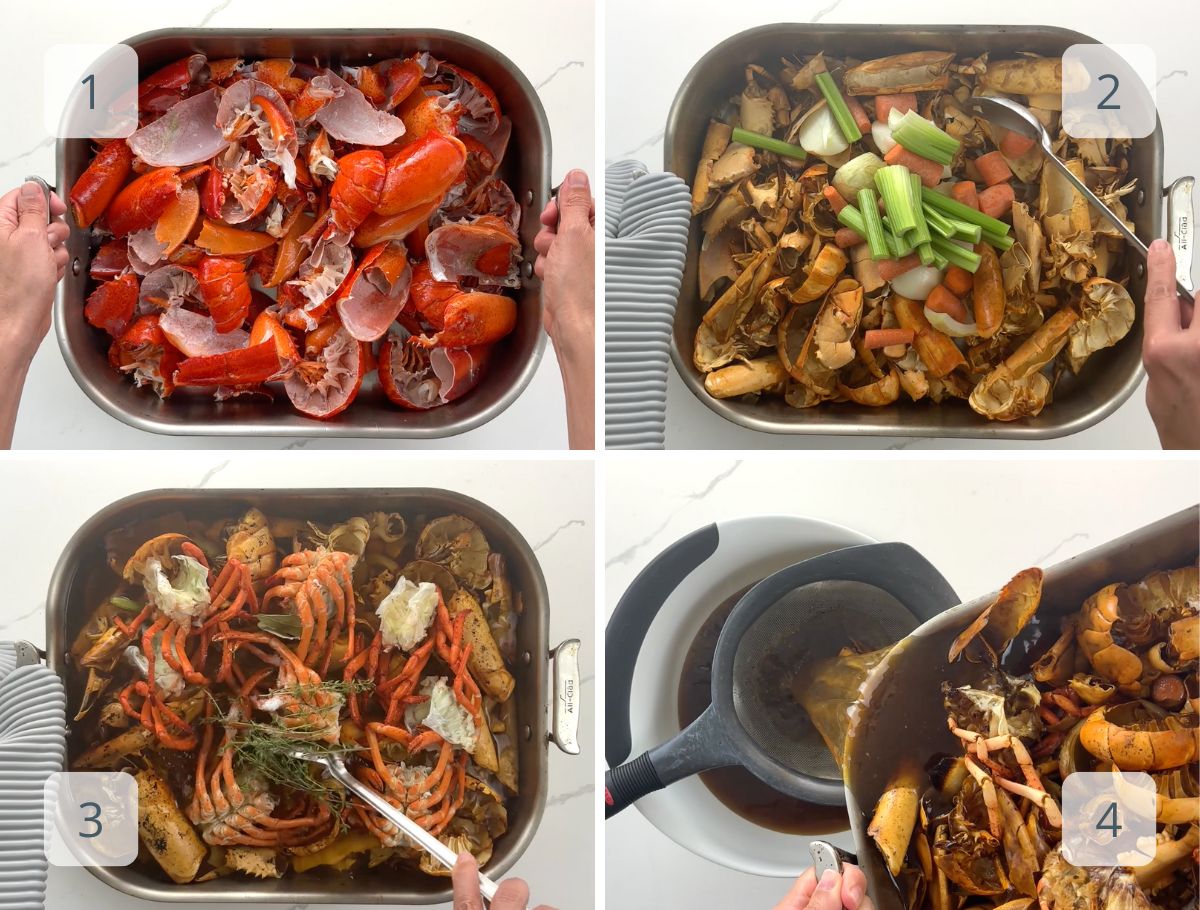This post may contain affiliate links. Learn more.
Rich, flavorful lobster stock is easy and relatively quick to make from leftover lobster shells. Use it for bisque, risotto, and more.

Why we love this recipe
This lobster stock has a rich, balanced flavor profile that will take your seafood recipes to the next level. It’s got:
- Lobster shells roasted in plenty of fat to extract all the flavor compounds
- A classic blend of vegetables and aromatics
- Tons of lobster flavor to enhance your seafood recipes
- A real knack for minimizing waste — those shells are pure gold
You’ll use the oven for the whole process, from roasting the shells to simmering the stock itself. Browning the ingredients well is an important part of the process, and that’s easier to do in a big roasting pan than on the stovetop.
What you’ll need
Here’s a glance at the ingredients you’ll need to make this recipe.

- The lobster flavor comes from two sources. First, you’ll clean and break apart the shells of eight(-ish) lobsters, including the carapaces (the shell that covers the body).
- If you haven’t eaten them, you’ll also include the bodies themselves, after removing the heads and lungs.
- Carrots, celery, and onions get roasted to perfection, too. You’ll trim off any dirty ends and quarter them — no need to peel.
- Garlic, tomato paste, thyme, bay leaves, and peppercorns round out the rich, classic flavor. I like to include salt in my stock, but you don’t have to.
- The liquid components are dry white wine (use one you’d like to drink), and lots of water (not pictured).
- You’ll use plenty of safflower oil (or another high-heat, neutral-tasting oil of your choice, such as peanut, canola, or vegetable oil blend). Some of the flavor compounds in the shells are fat-soluble, so the oil allows them to work their way into the stock.
Preparing lobster shells and bodies for roasting
This recipe presumes that you’ve already eaten (or picked) the meat from the lobster tails, claws, and knuckles. You’ll be starting with empty shells, plus the bodies if you haven’t picked them.
Prep
First you’ll separate the bodies (including spindly legs) from the carapaces (the part of the shell that covers the body). You’ll remove and discard the head sacs and the lungs. If you need help identifying these parts, here’s my very thorough post and video showing you how to shop for a live lobster, cook it, dismantle it, identify its parts, and extract every last morsel of meat.
Wash and dry
Next, you’ll rinse the shells and bodies well. I typically do this in a very large colander under running water. You’ll just want to remove any debris and remaining bits of tomalley and roe.
Dry everything well so that it will brown in the oven rather than steaming.
Crush
Finally, you’ll want to break up the shells a bit into smaller pieces. I often make stock from new-shell lobsters in the summertime, since they’re easier to work with. If you go that route, you’ll be able to cut the shells into pieces with regular kitchen shears. If you’re working with hard shells, you can place them in a zip-top bag a few at a time and break them with a mallet.
How to make it
Here’s an overview of what you’ll do to make a batch of rich, flavorful lobster stock. You can see the steps in action in the video that accompanies this post, and get all the details in the recipe card below.

- First you’ll roast the cleaned shells with plenty of oil.
- Add the vegetables and continue roasting, followed by the garlic, tomato paste, and then wine.
- Add lots of water along with the cleaned lobster bodies and the herbs and return to the oven until reduced by about 1/3.
- Strain and use in recipes or freeze for later. That’s it!
Expert tips and FAQs
This stock makes a wonderful base for lobster risotto and Maine lobster bisque.
Definitely. This recipe freezes well, so you can feel confident making it in advance and storing it in the fridge for up to a week or in the freezer for up to a year.
More favorite lobster recipes
- Butter-poached lobster tails
- Sous vide lobster tails
- The best lobster rolls (Maine-style or Connecticut-style)

Summarize & Save This Content On

Lobster Stock
Ingredients
- Shells of eight lobsters, along with bodies, if available (see notes section below for prep instructions)
- ½ cup (120 ml) safflower oil
- 2 medium yellow onions, trimmed and quartered
- 4 medium carrots, trimmed and quartered
- 4 ribs celery, including any leaves, trimmed and quartered
- 4 large garlic cloves, smashed
- 2 tablespoons (60 grams) tomato paste
- 2 cups (475 ml) dry white wine
- 20 cups 4.7 liters water
- 8 medium thyme sprigs, including stems
- 2 large bay leaves
- 12 black peppercorns
- 1 tablespoon fine sea salt, optional
Instructions
- Preheat oven to 400°F with a rack in the center.
- Place the prepared shells (but but not yet the bodies) into a large roasting pan. Pour in the oil and toss to coat evenly.
- Roast until quite pale and beginning to brown, about an hour.
- Stir in the onion, carrot, and celery and return to oven. Roast until vegetables are beginning to brown, about 40 minutes.
- Stir in the garlic and tomato paste and return to oven for 10 minutes.
- Pour in the wine, and stir, scraping up any brown bits from the bottom of the pan. Return to oven for five minutes more.
- Add the water, thyme, bay leaves, peppercorns, and salt, if using. Return to oven for about two hours, until liquid is reduced by 1/3 or so and stock is a rich golden brown. You will not necessarily see the stock simmering, but you should begin to see it reducing after an hour or so.
- Remove from oven and let cool substantially in the pan.
- Line a fine-mesh sieve with cheesecloth and carefully strain the stock into a large bowl.
- Discard solids and use strained stock in recipes or freeze for up to a year.
Notes
- I use the same roasting pan that I haul out for the Thanksgiving turkey. It's 16 3/4" x 13 3/4" x 3" high.
- Use a dry white wine that you'd be happy to drink.
- Safflower oil is my high-smoke-point, neutral-tasting vegetable oil of choice. You can substitute another oil that has similar properties, such as canola, sunflower, peanut, corn, or vegetable oil blend.
- This recipe freezes well, so you can feel confident making it in advance and storing it in the fridge for up to a week or in the freezer for up to a year.
- Since stock is an equal amount of work whether you're making a little or a lot, and it freezes beautifully, I like to make a nice big batch at once. You can halve the recipe if that better suits your needs.
Preparing lobster shells and bodies for roasting
This recipe presumes that you've already eaten (or picked) the meat from the lobster tails, claws, and knuckles. You'll be starting with empty shells, plus the bodies if you haven't picked them.- First you'll separate the bodies (including spindly legs) from the carapaces (the part of the shell that covers the body). You'll remove and discard the head sacs and the lungs. If you need help identifying these parts, here's my very thorough post and video showing you how to shop for a live lobster, cook it, dismantle it, identify its parts, and extract every last morsel of meat.
- Next, you'll rinse the shells and bodies well. I typically do this in a very large colander under running water. You'll just want to remove any debris and remaining bits of tomalley and roe.
- Dry everything well so that it will brown in the oven rather than steaming.
- Finally, you'll want to break up the shells a bit into smaller pieces. I often make stock from new-shell lobsters in the summertime, since they're easier to work with. If you go that route, you'll be able to cut the shells into pieces with regular kitchen shears. If you're working with hard shells, you can place them in a zip-top bag a few at a time and break them with a mallet.
Nutrition
Nutrition information is automatically calculated, so should only be used as an approximation.













Sorry, I meant foil not oil
Hi Tyler, reducing the stock is part of the process, so I don’t cover the pan. Hope you love the recipe!
Just making sure that we’re not covering the roasting pan with oil during these processes. ??
What if I do not have the carapace- can I make this with just the tail shells?
Sure! It won’t have quite as much body, but it will still be great.